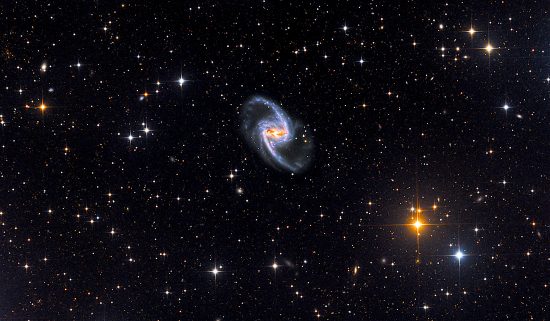Aug 2, 2018
Oxygen is abundant in the Universe.
Previous Picture of the Day articles point out that planetary nebulae radiate in light frequencies associated with ionized oxygen. Since oxygen is the most common element in galactic structures, after hydrogen and helium, it is not surprising that a remote galaxy exhibits a strong oxygen spectrum.
According to a recent press release, NGC 1365, a barred spiral galaxy that is among the largest ever discovered, exhibits 60 percent more oxygen in its spiral arms than in the gases and dust between them.
Astronomers do not know why there is such a high concentration, and they are uncertain of the mechanism that is responsible, especially since “…it would not have been predicted…” by their models of star formation in galaxies. They are constrained by gravitational models of the Universe that involve nuclear fusion, so electric fields and the flow of electric charge are not considered when deciding how to construct their ideas.
Stars within clouds of gas orbiting NGC 1365 are said to explode, releasing oxygen that has been formed in their core fusion reactors. The “debris” from supernovae between spiral arms is thought to be carried into subsequent arms as the clouds pass into them, giving new stars a boost of oxygen. “Turbulence” then dilutes the oxygen when it mixes with other gases, so the spaces between arms lack the element.
Consensus astronomers do not know why stars explode and expel clouds of gas and dust. Their reports about supernovae almost always include exceptions that are “puzzling” or “unpredictable.” Stars are not hydrogen fusion systems that forge new elements out of heat and pressure, they are the foci of Birkeland currents that make up circuits flowing around the galaxy.
Instead of gravity and cold gas, new stars are created in a boost of electric current. The electric sheaths around new stars receive input from the galactic Birkeland currents in which they are immersed, and get pushed into the “glow” discharge state. Gravity has little, if anything, to do with the processes of star formation.
Astronomers believe that galaxies are constructed out of hydrogen gas and intergalactic dust until they coalesce into assemblies of thermonuclear fire. They also believe that gigantic black holes power galactic activity, causing them to spin, expel jets of gamma and X-rays, and to generate “radio lobes”, sometimes larger than the galaxy, itself.
Instead, galaxies move within a filamentary circuit of electricity that flows through the cosmos. Electricity organizes itself within masses of plasma sometimes larger than galaxy clusters. That plasma is primarily composed of neutral atoms, but free electrons, protons and other charged particles are also present. Since primal electrical energy is orders of magnitude more powerful than gravity, electric charge flowing through dusty plasma sustains stars and galaxies.
As mentioned in previous Pictures of the Day, fusion occurs, not in the centers of stars, but on their surfaces. Fusion reactions can also occur when charge separation reaches a trigger point in ionized plasmas, releasing cosmic lightning bolts. Since a supernova results from stored electromagnetic energy release, as well (similar to a capacitor shorting out), electric charge becomes concentrated at one point, blasting out radiation across the entire electromagnetic spectrum, from radio to gamma rays. Elements heavier than hydrogen and helium are formed in those events.
Since power is calculated by the formula, P(W) = E(J) / t(s), a 5 billion Joule lightning bolt on Earth, lasting 2 seconds, releases 2.5 billion watts of power. One can imagine the power output from the double layer explosion of a star. It is no wonder that so much oxygen is concentrated in the spiral arms of galaxies like NGC 1365. They are where electric charge flows back to the galactic core, causing the greatest accumulation of electric stars.
Stephen Smith













